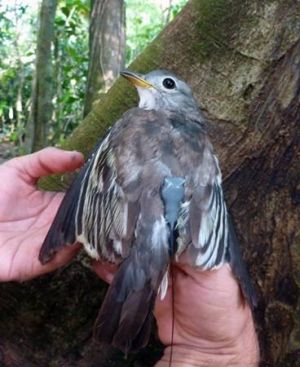
Publisher:
Bonnie King
CONTACT:
Newsroom@Salem-news.com
Advertising:
Adsales@Salem-news.com

~Truth~
~Justice~
~Peace~
TJP
Feb-28-2011 16:43

 TweetFollow @OregonNews
TweetFollow @OregonNews
Rare Bird Captured for First Time, Fitted With Tracking Device and Released
Salem-News.comYellow-billed Cotingas are about the size and shape of a pigeon and are strong flyers.
 Yellow-billed Cotinga female. Photo: Karen Leavelle |
(WASHINGTON. D.C.) - American Bird Conservancy (ABC), and a leading Costa Rican environmental organization – the Friends of the OSA, today reported that three endangered Yellow-billed Cotingas (a female and two males) were for the first time ever, captured using mist nets, fitted with tracking devices and released unharmed near the Costa Rican town of Rincon.
This rare bird about which relatively little is known is endemic to the Pacific slope mangrove forests of Panama and Costa Rica. Its capture and study is part of a project funded by the Mohammad bin Zayed Foundation and being carried out jointly by ABC and Friends of the OSA (an environmental group that focuses on conservation in the OSA Peninsula, Costa Rica).
“This is a bird that we believe used to exist in large numbers but is now increasingly difficult to even glimpse, much less study. This is an outstanding opportunity to acquire information on this bird and take action to address its habitat needs now before it is too late.” said Andrew Rothman, ABC conservation biologist who oversees ABC programs in Costa Rica.
“Placing a radio transmitter on a rare and endangered species such as the Yellow-billed Cotinga is a tremendous responsibility as well as a great opportunity which will open the door to a wealth of ecological and behavioral information; especially information on its seasonal movements and habitat use, that will guide us in protecting this little known bird,” says Karen Leavelle, who is Friends of the Osa’s Chief Investigator on the project.
The birds were captured in mist nets on February 15, 16 and 17. The female was the first to hit the net on Tuesday, followed by the first male on Wednesday and another male on Thursday. The captured female weighed 2.75 ounces (78grams) and the two males weighed 2.89 ounces (82 grams) and 3.25 ounces (92 grams). The birds were fitted in the field with harnesses carrying radio transmitters that will allow them to be tracked over the next 6 – 10 months. Researchers will look at home range, feeding and reproductive habits, and habitat use to develop a conservation plan for this species in the Osa. All three captured cotingas are now moving around the Rincon area. Researchers plan to capture two more.
Yellow-billed Cotingas are about the size and shape of a pigeon and are strong flyers. Males are bright white, with yellow bills and perform swooping flight displays to attract females. Despite their efforts at being conspicuous, little remains known about this species due to the lack of scientific research on the species. Much of their former range has been deforested in both Costa Rica and Panama, so the birds are thought to be in decline.
In 2007, ABC and Friends of the Osa began working with local birding guides to monitor birds in the Osa Peninsula and Golfo Dulce region of southern Costa Rica, thought to be the stronghold for the Yellow-billed Cotinga. The two organizations conducted bird counts across the region, with a focus on areas where they might find cotingas.
In 2008 and 2009, adult Yellow-billed Cotingas were found feeding on fruiting trees in most of the areas where healthy forests remained close to mangroves, including the Rio Esquinas area. It was there that the first-ever nest was observed, with one nestling, in a mangrove tree (though unfortunately the nest was later predated).
Since then, multiple sightings of adult females accompanied by fledglings have occurred in mangroves and males have been seen displaying in forests far from coastal mangroves though no evidence has been found that females nest there. Therefore, it seems that this is a bird that prefers to nest in mangroves and dine in the forests -- requiring both habitats, probably in close proximity, to survive.
The Osa Peninsula of Costa Rica is blessed with a significant number of large national parks, national wetlands, and forest reserves. However, many of the most important places where mangroves and forests meet, where the cotingas appear most abundant, fall within unprotected gaps outside this system of protection.
American Bird Conservancy conserves native birds and their habitats throughout the Americas by safeguarding the rarest species, protecting and restoring habitats, and reducing threats while building capacity of the bird conservation movement. For more information, visit, www.abcbirds.org
Articles for February 27, 2011 | Articles for February 28, 2011 | Articles for March 1, 2011



Quick Links
DINING
Willamette UniversityGoudy Commons Cafe
Dine on the Queen
Willamette Queen Sternwheeler
MUST SEE SALEM
Oregon Capitol ToursCapitol History Gateway
Willamette River Ride
Willamette Queen Sternwheeler
Historic Home Tours:
Deepwood Museum
The Bush House
Gaiety Hollow Garden
AUCTIONS - APPRAISALS
Auction Masters & AppraisalsCONSTRUCTION SERVICES
Roofing and ContractingSheridan, Ore.
ONLINE SHOPPING
Special Occasion DressesAdvertise with Salem-News
Contact:AdSales@Salem-News.com

Terms of Service | Privacy Policy
All comments and messages are approved by people and self promotional links or unacceptable comments are denied.
[Return to Top]
©2025 Salem-News.com. All opinions expressed in this article are those of the author and do not necessarily reflect those of Salem-News.com.